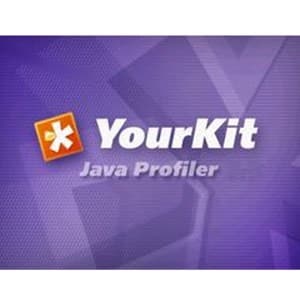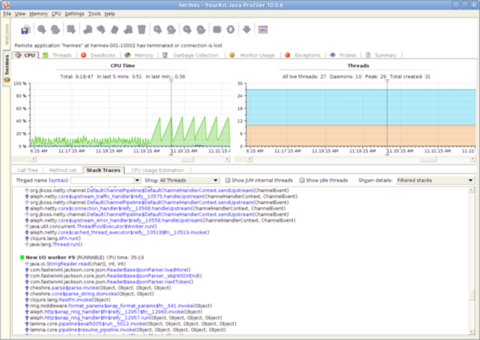


#Yourkit java profiler 8.0 full
JAVA_OPTS: -server -Xms64m -Xmx512m -XX:MetaspaceSize=96M -XX:MaxMetaspaceSize=256m 4Stack=true =com.yourkit, =trueġ1:46:11,161 INFO (main) JBoss Modules version 1.5.1.Finalġ1:46:11,331 INFO (main) JBoss MSC version 1.2.6.Finalġ1:46:11,391 INFO (MSC service thread 1-6) WFLYSRV0049: WildFly Full 10.0.0.Final (WildFly Core 2.0.10.Final) startingġ1:46:14,300 INFO (Controller Boot Thread) WFLYSRV0025: WildFly Full 10.0.0.Final (WildFly Core 2.0.10.Final) started in 1909ms - Started 267 of 553 services (371 services are lazy, passive or on-demand)Īs with previous WildFly releases, you can point your browser to (if using the default configured http port) which brings you to the Welcome Screen:įrom here you can access links to the WildFly community documentation set, stay up-to-date on the latest project information, have a discussion in the user forum and access the enhanced web-based Administration Console. In each server's subdirectory there will be the following subdirectories: data - information written by the server that needs to survive a restart of the server log - the server's log files tmp - location for temporary files written by the server Each Application Server instance will have its own subdirectory, created when the server is first started. Writable area used by each Application Server instance that runs from this installation. The Process Controller, a small lightweight process that actually spawns the other Host Controller process and any Application Server processes also writes a log here. Location where the Host Controller process writes its logs.

Note that " domain" mode does not support deploying content based on scanning a file system. This directory is not meant to be manipulated by end users. This is where it internally stores deployment content. All configuration information for the servers managed wtihin the domain is located here and is the single place for configuration information.Īn internal working area for the Host Controller that controls this installation. Special location used to exchange authentication tokens with local clients so they can confirm that they are local to the running AS process.Ĭonfiguration files for the domain and for the Host Controller and any servers running off of this installation. Location for temporary files written by the server Location for installed library jars referenced by applications using the Extension-List mechanism File system based deployment scanning capabilities remain for developer convenience. NOTE: The server's management API is recommended for installing deployment content. Persistent information written by the server to survive a restart of the serverĮnd user deployment content can be placed in this directory for automatic detection and deployment of that content into the server's runtime. All configuration information for the running server is located here and is the single place for configuration modifications for the standalone server. JSR-45: Debugging Support for Other Languages 1.0Ĭonfiguration files for the standalone server that runs off of this installation. JSR-88: Java EE Application Deployment 1.2 JSR-115: Java Authorization Contract for Containers 1.5 JSR-196: Java Authentication Service Provider Interface for Containers 1.1 JSR-181: Web Services Metadata for the Java Platform JSR-224: Java API for XML-Based Web Services 2.2

JSR-109: Implementing Enterprise Web Services 1.3 JSR-339: Java API for RESTFul Web Services 2.0 JSR-250: Common Annotations for the Java Platform 1.2 JSR-322: Java EE Connector Architecture 1.7 JSR-330: Dependency Injection for Java 1.0 JSR-346: Contexts and Dependency Injection for Java 1.1 JSR-236: Concurrency Utilities for Java EE 1.0 JSR-352: Batch Applications for the Java Platform 1.0 JSR-52: Standard Tag Library for JavaServer Pages (JSTL) 1.2


 0 kommentar(er)
0 kommentar(er)
